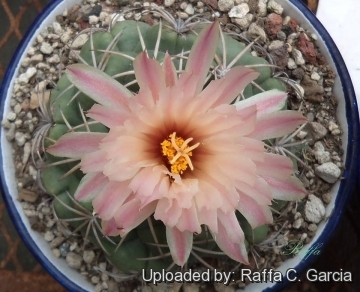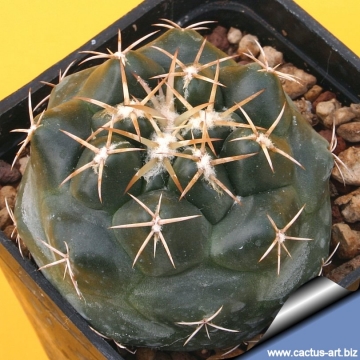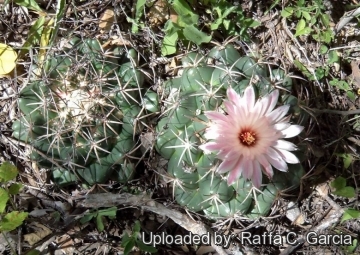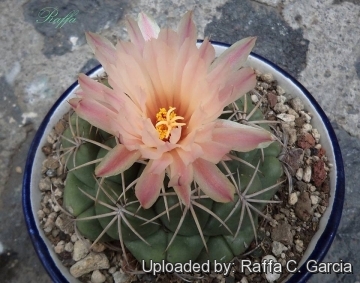Accepted Scientific Name: Coryphantha elephantidens (Lem.) Lem.
Cactées 35. 1868

Echinocactus elephantidens (Coryphantha elephantidens) Photo by: Raffa C. Garcia
Blooming habit, in Mexico.
Origin and Habitat: Coryphantha elephantidensSN|3920]]SN|3920]] is endemic to Mexico where it is known to occur in the states of Aguascalientes, Guerrero, Guanajuato, Hidalgo, Jalisco, México, Michoacán, Morelos, Oaxaca, Puebla, Querétaro, Veracruz and Zacatecas. The subsp. greenwoodii has a restricted range near Piedras Blancas, Veracruz. Subsp.bumamma is recorded from the States of Oaxaca and Michoacán.
Altitude: 1100-2000 metres above sea level.
Habitat and Ecology: Coryphantha elephantidensSN|3920]]SN|3920]] is found in grasslands and xerophyllous scrub. It is widespread and relatively common and is threatened by deforestation from small-holder agriculture and cattle ranching. In the same area it is possible to find several cactus and succulent species like: together with Mammillaria elegansSN|20632]]SN|13998]], Mammillaria uncinataSN|14267]]SN|14267]], Mammillaria hubertmulleriSN|13998]]SN|20632]], Stenocereus dumortieriSN|25145]]SN|7942]], Stenocereus stellatusSN|7945]]SN|7945]], Stenocereus beneckeiSN|7942]]SN|25145]], Opuntia pumila, Opuntia tomentosa, Myrtillocactus geometrizansSN|8050]]SN|8050]] and the palm Brahea dulcisSN|24746]]SN|24746]].
Synonyms:
See all synonyms of Coryphantha elephantidens
Common Names include:
ENGLISH: Elephants Tooth, Elephant's Tooth, Starry Ball
SPANISH (Español): Biznaga partida diente de elefante
Description: Coryphantha elephantidensSN|3920]]SN|3920]] is a large, depressed-globular cactus, simple or occasionally clumping and group-forming. C. elephantidens usually has pink flowers but they can sometimes be yellow. This species comprises three subspecies - the typical form, subsp. bumamma (Ehrenb.) Dicht & A.Lüthy, and subsp. greenwoodii (Bravo) Dicht & A.Lüthy.
Derivation of specific name: The epithet 'elephantidens' comes from Latin and means 'elephant tooth' and describes the fang-like spines of this species.
Stems: Simple, flattened globular to subglobose, up to 14(-19) cm in diameter and 14 cm high, glossy dark green, subglaucous.
Tubercles; Very large, , somewhat flattened, 20-30 (60) mm wide, obtuse, rounded on top, pentaedrical at the base, 4 to 5 cm wide, always broader than rounded, without glands, the tubercles axil is densely woolly.
Areoles: Elliptic, when young woolly, in age naked.
Spines: The tubercles are capped with a 5-8 of stout reflexed radial spines, spreading, somewhat unequal, 18-26 mm long, strong, subulate, curved, never porrect, but adpressed to the body, when young brownish with yellowish bases, black at apex. Central spines are absent.
Flowers: Sweet smelling large 6 to 11 cm whitish broad, perianth-segments numerous, narrowly oblong, apiculate rose-colored to purple pink or white with a reddish throat and reddish median strip, (rarely yellow).
Blooming season:: Late summer to autumn.
Fruits: Very big, ca. 4 cm long and 1 cm in diameter.
Subspecies, varieties, forms and cultivars of plants belonging to the Coryphantha elephantidens group
 Coryphantha elephantidens (Lem.) Lem.: Large, depressed-globular cactus, often clumping with large dark-green tubercles rounded on top, the tubercles axil is very woolly. The radial spines are stout reflexed and adpressed to the body. Flowers whitish, yellow or pink.
Coryphantha elephantidens (Lem.) Lem.: Large, depressed-globular cactus, often clumping with large dark-green tubercles rounded on top, the tubercles axil is very woolly. The radial spines are stout reflexed and adpressed to the body. Flowers whitish, yellow or pink. Coryphantha elephantidens f. aurea hort.: Mutant lacking chlorophyll pigment. The result is a completely cream-yellow or golden-yellow plant.
Coryphantha elephantidens f. aurea hort.: Mutant lacking chlorophyll pigment. The result is a completely cream-yellow or golden-yellow plant.- Coryphantha elephantidens var. barciae L.Bremer: It has a big tap-root. Parastichy number 8/13.
 Coryphantha elephantidens subs. bumamma (Ehrenb.) Dicht & A.Lüthy: Strongly offsetting species forming large groups up to 50 cm in diameter. Stem glaucous green. It is very similar to Coryphantha elephantidens but the flower are much smaller and nearly yellow.
Coryphantha elephantidens subs. bumamma (Ehrenb.) Dicht & A.Lüthy: Strongly offsetting species forming large groups up to 50 cm in diameter. Stem glaucous green. It is very similar to Coryphantha elephantidens but the flower are much smaller and nearly yellow.- Coryphantha elephantidens subs. greenwoodii (Bravo) Dicht & A.Lüthy: Solitary or group-forming, flat-globose mostly under the ground-level, intermediate between Coriphantha elepantidens and Coriphantha pycnacantha.
- Coryphantha elephantidens var. recurvispina (de Vriese) hort., nov. comb. ined.: Solitary, depressed, about 16 cm. in diameter, tubercles few, large, glaucous, obtuse; areoles and axils naked ; spines all radial, 8 more or less incurved. ( = Coryphantha elephantidens)
- Coryphantha elephantidens var. roseiflora Y.Itô: Pink flowering form.
 Coryphantha elephantidens subs. sulcolanata (Lem.) hort., nov. comb. ined.: Very similar (if not the same plant) to Coryphantha elephantidens but the flowers are always yellow and never pink. Origin: Hidalgo.
Coryphantha elephantidens subs. sulcolanata (Lem.) hort., nov. comb. ined.: Very similar (if not the same plant) to Coryphantha elephantidens but the flowers are always yellow and never pink. Origin: Hidalgo. Coryphantha elephantidens f. variegata hort.: Variegated form. The stems have sectors, patches or stripes with two colours, yellow and green. There are several forms of variegation.
Coryphantha elephantidens f. variegata hort.: Variegated form. The stems have sectors, patches or stripes with two colours, yellow and green. There are several forms of variegation.  Coryphantha elephantidens cv. Tanshi Zougemaru: Cultivar with short but strong spines and very large tubercles. Flowers pink. Origin: Japan.
Coryphantha elephantidens cv. Tanshi Zougemaru: Cultivar with short but strong spines and very large tubercles. Flowers pink. Origin: Japan. Coryphantha elephantidens cv. Tanshi Zougemaru inermis
Coryphantha elephantidens cv. Tanshi Zougemaru inermis Coryphantha garessii L.Bremer: Probable synonym of Coryphantha elephantides. Origin: Zacatecas
Coryphantha garessii L.Bremer: Probable synonym of Coryphantha elephantides. Origin: Zacatecas
Notes: Coryphantha elephantidensSN|3938]]SN|3920]] is the centre of a complex of closely related species and it is quite difficult to decide about what is the valid names or eventual subspecies of the different taxon at present time. The complex comprises: Coryphantha elephantidensSN|3939]]SN|3920]] (Lemaire 1838) Lemaire 1868 Coryphantha sulcolanataSN|3933]]SN|3928]] (Lemaire 1838) Lemaire 1868, Coryphantha recurvispinaSN|3925]]SN|3925]] (De Vriese 1839) Bremer 1976 Coryphantha bumammaSN|3928]]SN|3933]] (Ehrenberg 1849) Britton & Rose 1923 Coryphantha greenwoodiiSN|3920]]SN|3939]] Bravo 1970 and Coryphantha garessiiSN|3920]]SN|3938]] Bremer 1980.
Bibliography: Major references and further lectures
1) Edward Anderson “The Cactus family” Timber Press, Incorporated, 2001
2) James Cullen, Sabina G. Knees, H. Suzanne Cubey "The European Garden Flora Flowering Plants: A Manual for the Identification of Plants Cultivated in Europe, Both Out-of-Doors and Under Glass" Cambridge University Press, 11/Aug/2011
3) David R Hunt; Nigel P Taylor; Graham Charles; International Cactaceae Systematics Group. "The New Cactus Lexicon" dh books, 2006
4) Hernández, H.M., Gómez-Hinostrosa, C., Guadalupe Martínez, J., Sánchez , E., Dicht, R.F. & Lüthy, A.D. 2013. Coryphantha elephantidens. In: IUCN 2013. "IUCN Red List of Threatened Species." Version 2013.2. <www.iucnredlist.org>. Downloaded on 17 February 2014.
5) Nathaniel Lord Britton, Joseph Nelson Rose “Cactaceae: Descriptions and Illustrations of Plants of the Cactus Family” vol. 4 The Carnegie Institution of Washington, Washington 1923
6) Graham Charles “Cacti and Succulents: An illustrated guide to the plants and their cultivation” Crowood, 30 Apr 2014
7) Paul Carpenter Standley, United States National Museum “Trees and Shrubs of Mexico: Passifloraceae-Scrophulariaceae” U.S. Government Printing Office, 1924
8) CONABIO. "Catálogo taxonómico de especies de México." 1. In Capital Nat. México. CONABIO, Mexico City. 2009
9) Urs Eggli, Leonard E. Newton “Etymological Dictionary of Succulent Plant Names. Birkhäuser” 2004
10) Charles Antoine Lemaire “Cactearum aliquot novarum ac insuetarum in Horto monvilliano cultarum accurata descriptio.” 1838.
 Echinocactus elephantidens (Coryphantha elephantidens) Photo by: Raffa C. Garcia
Echinocactus elephantidens (Coryphantha elephantidens) Photo by: Raffa C. Garcia Echinocactus elephantidens (Coryphantha elephantidens) Photo by: Cactus Art
Echinocactus elephantidens (Coryphantha elephantidens) Photo by: Cactus Art Echinocactus elephantidens (Coryphantha elephantidens) Photo by: Raffa C. Garcia
Echinocactus elephantidens (Coryphantha elephantidens) Photo by: Raffa C. Garcia Echinocactus elephantidens (Coryphantha elephantidens) Photo by: Raffa C. Garcia
Echinocactus elephantidens (Coryphantha elephantidens) Photo by: Raffa C. GarciaCultivation and Propagation: Full sun to light shade in summer. Water sparingly, keep drier in winter. Needs good drainage. Frost Tolerance: Hardy to -3°C.
Propagation:: Offsets as it is a suckering cactus or by seeds.














